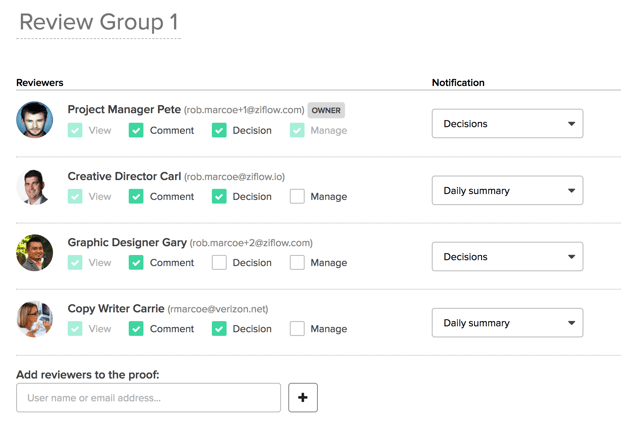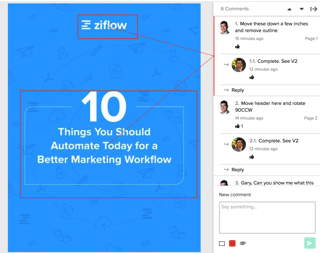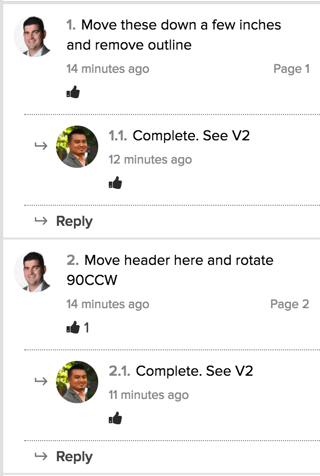
Prior to his role at Ziflow, Mike led ProofHQ's marketing team to a triumphant exit through its acquisition by Workfront.
It's time to replace email with a purpose-built feedback tool. Ziflow's online proofing app will help you deliver projects faster, every day.
![]() Mike Puterbaugh 1 May 2020 READ TIME: 7 MIN
Mike Puterbaugh 1 May 2020 READ TIME: 7 MIN

Memos, promotional offers and password reset emails - these are all things that email is very good for. As a mechanism for providing feedback, however, it lacks some very important requirements for fast, accurate and quality work; specifically, context and clarity.
Forward-thinking marketing organizations have replaced email with a online proofing - cloud based applications which allow marketing teams to upload, share creative assets (such as PDF’s, design files, videos, audio files, etc.), and comment on them with precise feedback
Precise feedback requires context. Online proofing applications are more advantageous in this regards, because it allows for feedback to be provided directly on the content being reviewed (more on that later). his context - what specific aspect of the content feedback is being provided for - drives greater clarity - what the feedback is actually trying to communicate.
We’ve assembled a few reasons for you to consider ditching email as your primary feedback tool. We’ve also included some immediate productivity gains that can be achieved by implementing online proofing.
Sending creative assets to a group for review via email typically means loading up the “to” line with your stakeholders and hoping for the best. Once you hit send, you lose control and visibility.
How can you be 100% positive that the content won’t be shared outside your team, or outside the company? It’s really hard to ensure the content stays within the group at that point. Not only that, but unless you’ve requested read-receipts for each email (and who has time to keep track of those?), you’re left with little visibility as to when your team members will be spending time on your request.
WIth online proofing you regain the control of distribution, first by creating your review group, which can vary project by project, and setting granular controls on what they can or can’t do (such as download the original, or provide a public URL to the proof).

Another challenge of email as it relates to on-time project delivery, is its inability to quickly convey the status of a review. Unless your project manager or designer is a disciplined user of read-receipts (again, who has time for that?), there’s no guarantee that your team members even know there is content ready for review, waiting for them in their inbox.
Beyond notification, there’s also no indication of progress. Who has made comments? Who has indicated that changes are required? Was an approval received, somewhere in an email thread? With email, the only way to find out is to start scrolling through endless “reply-all’s” hoping to find out where the review process stands.
Online proofing solutions provide users with a proof summary, where progress and status can be gleaned at a glance. There you’ll see which team members have opened the proof, provided comments, and if applicable, if they’ve made any decisions on the proof. Now there’s no need for the team-wide “please reply” email - you know immediately who has engaged with the proof. 
“Make the logo bigger”, “Bump up the font a few points”, “Can we try a drop shadow underneath the picture?” Each of these pieces of feedback, when provided via email, are of no help to a designer who needs specific, actionable requests.
The result is that the designer or production/project manager often asks for clarification, or worse, makes assumptions in the name of progress. This satisfies no one and ultimately causes re-work and lost time.

Online proofing systems streamlinesthe feedback process, by providing annotation and markup tools directly on the asset itself, connected to a commenting system which provides crystal clear direction for the entire team to review. This translates into immediate the immediate ROI of fewer revisions and reduced re-work requests due to errors.
As mentioned earlier, email is an effective method for certain types of communications. However, when it comes to collaborating with colleagues on time-sensitive projects which require specific actions to be taken, it can be a major productivity drain for your team.
Group conversations become unwieldy with the first “reply all”, and devolve with each new broadcast reply or single line comment intended as feedback. As inboxes begin to fill up, there’s no easy way to determine what each new comment is related to, or if that feedback was given already.
To streamline the feedback process and improve collaboration, an online proofing system provides easy to use commenting (with replies and attachments, for further clarity) and markup tools allow team members to provide clear, actionable feedback.

Providing and collecting feedback in this centralized manner helps marketing teams avoid delays created by ad-hoc feedback paths such as email.
You’ve picked apart email threads, collated feedback in and you’ve made the requested changes. Now comes the fun part - sending out another version for review. You’ve got some tough questions to answer before you can hit send;
Not really the fun part, is it? Not only do you have to answer those questions for yourself, but you also need to figure out how to avoid the eventual feedback that will come in late, on the v1, while v2 has already been circulated. For those late to the game, the creative team will also be asked to provide a quick “what’s changed” summary, in email of course.
Online proofing is superior to email in that it provides an easy to administer version control system. When a new version of a proof is added, previous comments and markups are saved, and the previous version is locked. This means team members can’t mistakenly provide feedback on a previous version, slowing down the project in the process.
Another productivity win that should be a requirement for any review and approval software deployment is pixel-by-pixel compare mode, which allows reviewers to see versions side by side, saving the creative team from having to write up what’s changed and keeping projects moving toward completion.
We could go on and on with reasons why to ditch email as a marketing feedback tool, these paragraphs practically write themselves.
You’ve modernized other aspects of your marketing stack, isn’t it time to upgrade your review and approval process?
If your marketing team wants to streamline the review and approval of creative content to deliver marketing projects faster, with more quality, then you should try a free 14 day trial of Online Proofing by Ziflow.

Prior to his role at Ziflow, Mike led ProofHQ's marketing team to a triumphant exit through its acquisition by Workfront.
See how Ziflow's collaborative proofing platform supports all of your campaigns and channels.

Explore the top six creative workflow automation tools to streamline projects, speed approvals, and boost collaboration for marketing and design teams...

Discover how to maintain brand consistency across marketing campaigns and assets. See challenges, best practices, and how Ziflow ensures creative alig...

Discover the 6 best video review software tools for creative teams. Get faster approvals, clear feedback, and streamlined workflows in one, unified pl...
Subscribe to our newsletter for product updates and industry insights.
GET STARTED
TEAMS
INTEGRATIONS
INDUSTRIES